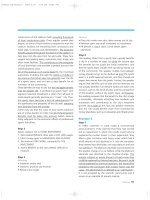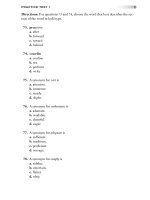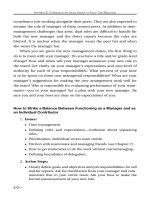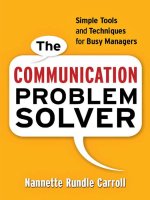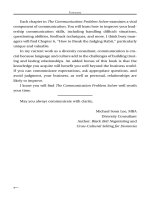The Communication Problem Solver 11 pdf
Bạn đang xem bản rút gọn của tài liệu. Xem và tải ngay bản đầy đủ của tài liệu tại đây (70.63 KB, 10 trang )
H
OW TO
U
SE
Y
OUR
P
ROCESS
S
KILLS TO
P
REVENT AND
S
OLVE
C
OMMUNICATION
P
ROBLEMS
rather than the status quo, check for accuracy, and examine the compre-
hensiveness of their thinking. Questioning assumptions and presupposi-
tions can lead to higher quality work and job satisfaction.
Questions can also help people build and sustain healthy work rela-
tionships. Thoughtful questions can demonstrate trust and interest in
the employees’ intellectual capacity. These questions can be a factor in
expanding employees’ development and ability to take on more stimu-
lating assignments. Asking questions shows attention to employees and
their ideas, demonstrates that the manager has the competence to know
what to ask to advance the task or project, and helps the employee en-
hance professional skills and knowledge by widening the scope of possi-
bilities.
Managers adept in questioning techniques enable employees to take
ownership of their work challenges. Questions assist direct reports in
thinking about and solving their own problems and making their own
decisions. This leads to enhanced employee competence and indepen-
dence on tasks and projects. Thinking independently fortifies employ-
ees’ proficiency and confidence.
Questioning is an important part of setting expectations and delega-
tion. Since individuals’ perceptions may vary considerably, questioning
is used to clarify goals, assignments, action steps, and progress so that
the manager and direct reports have a common understanding. Manag-
ers state expectations that are perfectly clear to themselves. They then
use questions to clarify what the employees actually heard, which might
be quite different from what the manager intended.
During follow-up progress discussions, questioning assists a man-
ager in learning about his direct reports’ points of view and thinking
throughout the task or project. Asking appropriate questions can help
employees stay on task and focused on business goals and increase own-
ership of the work since the employee is the person with the answers to
the questions.
82—
T
OP
-T
IER
Q
UESTIONING
T
ECHNIQUES
Benefits of Questions
There are numerous benefits to knowing how to ask targeted questions.
When I was a manager, questioning skills enabled me to galvanize others
to create groups, departments, products, and services where none pre-
viously existed. Questioning techniques advance collaboration, fact-
finding, and innovation. They enable others to find ways to step up to
new directions.
Questions involve others in a collaborative discovery process. Ac-
complished managers facilitate learning and engage others every day.
Getting top results with and through other people requires setting the
climate for learning and engagement. Questions pull information from
capable people instead of pushing information at them. This reveals the
leaders’ trust in employees’ abilities and it helps build constructive rela-
tionships.
Mastering the technique of asking questions in an empathetic way
boosts the manager’s credibility. This questioning ability is essential to
successful listening, and listening shows consideration for others and
their contributions. Properly framed, empathetic questions advance
management communication goals.
However, questioning because managers think they are supposed to
ask questions has the opposite effect. Instead of enhancing a work rela-
tionship, it can injure it. If managers don’t want to listen to the answer,
they should not ask the question. When the manager asks questions but
already has a preferred answer in mind, this can also dent trust and
increase stress. Who wants their time and energy wasted? The next time
the manager questions the employees, they might shrug the question off
rather than invest themselves in a futile conversation.
When managers’ intentions are to build relationships, gather ideas,
and honestly collaborate for the best work result, questioning is a top-
tier tool. Using this tool, managers can communicate better and reap
rewards by developing their staff’s ability to fully contribute strengths to
the team.
—83
H
OW TO
U
SE
Y
OUR
P
ROCESS
S
KILLS TO
P
REVENT AND
S
OLVE
C
OMMUNICATION
P
ROBLEMS
Managers who use appropriate questioning techniques also benefit
employees in many ways. Employees learn how to ask questions by ob-
serving their managers do so effectively. They learn to work out interper-
sonal conflicts they have with coworkers by questioning and listening.
Employees learn to use process skills and think in factual terms. They
know they will be expected to present their opinions and data during
feedback and coaching and learn to better formulate questions to get the
information they need. By watching their manager, employees learn how
to express their ideas, listen to other ideas, and synthesize ideas for prac-
tical solutions to working with coworkers up, down, and across the orga-
nization. They broaden their perspective by asking questions themselves
and listening to others and learn about leadership. Direct reports also
may feel supported and valued for their contributions and be energized
and empowered.
Making Friends with Change
When I was a little girl, my mom called me ‘‘The Question Girl.’’ My
curiosity compelled me to constantly ask questions. I wanted the details
on just about every person, place, thing, idea, and situation I came
across. Mom encouraged this insatiable desire for continual learning.
Her nurturing of my natural inquisitiveness led me to believe that I do
not have to have all the answers. I can successfully collaborate with oth-
ers to explore ideas through questioning techniques. I can live in uncer-
tainty and thus be partner to change and innovation.
On the other hand, Dad did not discuss the topics with me. ‘‘Look it
up,’’ he would say. He referred me to books. Since there was no Internet
yet, I had to identify specifically what my question was so I could look
in the right part of the right books. I also learned to research for facts
and analyze for myself.
The combination of working with others to answer questions and
the research approach honed my searching abilities. The questions
burned and the answers always created new questions. Is this the way
84—
T
OP
-T
IER
Q
UESTIONING
T
ECHNIQUES
your work takes you—to a new twist constantly? Managing change is a
daily happenstance in most workplaces. Sharpening questioning skills
can prepare a manager to take on any new challenge with confidence.
Questions—Barrage or Communication Tool?
How can you work questions into a conversation without sounding like
you are interrogating a witness? Managers are influencers and facilita-
tors in their quest to get results. They need to facilitate daily work discus-
sions that include staff rather than put them on the defensive. How best
to do that?
Put the questions in the context of why you are asking. For example,
‘‘To make a good decision about selecting new software, I would like to
learn more about your research on the needs the various divisions have.
Is this a good time to ask you some questions?’’ Or, ‘‘Let’s ask each other
some questions about this new product proposal so we can advance the
ideas to the next level.’’ Or, when a person comes to you for advice, ‘‘I
know you can solve this problem yourself so instead of saying what I
would do, I am going to help you think through your own solution by
asking you some questions. Sound good?’’ Context gives the rationale for
the questions and also the benefits of answering. When people know
why they are being asked questions, they are usually more forthcoming
and willing to converse.
Another way to avoid coming across like you are cross-examining a
witness is to listen carefully. Listening to the person’s answer puts time
and space between the questions and makes for a conversation rather
than a barrage of questions. Reacting spontaneously to what the em-
ployee says in between the series of questions also creates a normal con-
versation.
Use a neutral, friendly tone of voice, and open, relaxed body lan-
guage. Make sure neither one of you is in a hurry. Take enough time for
the person to be comfortable if you have a list of questions to ask.
—85
H
OW TO
U
SE
Y
OUR
P
ROCESS
S
KILLS TO
P
REVENT AND
S
OLVE
C
OMMUNICATION
P
ROBLEMS
Four Types of Questions: Open, Closed, Behavioral,
and Situational
Let’s talk about four different types of questions and the purpose of each:
open, closed, behavioral, and situational. When deciding which type of
question you need, reflect on ‘‘What information do I need back?’’ Each
type of question will steer the person answering the question in a partic-
ular direction, so it’s important to know the purpose of each question
and how to word it.
Your questions educate employees about what is important to you
and the company. Are your questions high-level, or detailed? Are they
process-oriented and fact-finding, or opinion-based? Are they job-
related, or personal to you? Are they related to goals? Are they support-
ive, or accusatory? Do they relate to budget, timetables, and specifica-
tions? Do they direct the employee to think one way, or do they open
the possibility that the employee is capable of solving the problem and
deciding? Do they teach?
The questions you ask demonstrate your professionalism and com-
petence as a leader as well as a coach for technical expertise. The level of
your question shows how much knowledge you have about the technical
aspects of the job and how well you know this employee’s ability on
this particular task or project. Your query also signals how important the
relationship is to you, based on the words and tone you choose. You also
unveil the breadth of your management expertise by being able to flex
your style based on the style and needs of the employee.
With all that looming in the wings, the importance of word choice
and selecting the right type of question is elevated. Having a handle on
questioning techniques is indispensable for successful managers.
1. Open Questions
An open or open-ended question broadens the opportunity for a wide
array of responses. This type of question provides a chance for the per-
son answering the question to assess and state what he thinks is impor-
86—
T
OP
-T
IER
Q
UESTIONING
T
ECHNIQUES
tant, express his opinions, expand upon facts, suggest alternatives, and
apply his knowledge in varied ways. Open questions are useful for cre-
ative and collaborative problem solving and decision making.
Open questions elicit others’ ideas and assessments. Because em-
ployees’ ideas are considered and more ownership is invited, they may
bring a higher degree of motivation to the task or project.
Since these questions generally open the conversation to a number
of possible answers, you get more information than with closed ques-
tions. However, the challenge is that the person answering is free to an-
swer in many divergent ways not controllable by the questioner without
interrupting. Also, while the answers may help the manager to form a
general impression, the employee may not give specific examples or suf-
ficient detail. Such answers may require follow-up questions to probe
deeper. Another disadvantage is that answers to open questions may
lead to conversational detours, and the manager must be skilled to bring
the focus back to the issue at hand.
When to Use.
Open questions can be used during interviewing, delegat-
ing, project follow-up, monitoring progress on tasks and performance,
giving and receiving feedback, coaching, getting employees to assess
their achievements and performance, brainstorming, getting new ideas,
working collaboratively, listening, clarifying your understanding or
theirs, employee development, projects, assessing milestones, project
debriefs, and planning for future projects.
Open questions encourage the direct reports to explore an issue or
challenge them to analyze situations. They require more thinking than
closed questions. Process questions are the ones most professionals
wrestle with daily. They are mostly open-ended questions dealing with
problem solving, analysis, synthesis, comparing and contrasting, creat-
ing, and thinking.
Benefits to Manager.
Open questions are used to gather facts about
the work, learn about your employees’ process skills and approaches to
—87
H
OW TO
U
SE
Y
OUR
P
ROCESS
S
KILLS TO
P
REVENT AND
S
OLVE
C
OMMUNICATION
P
ROBLEMS
the tasks, discover what motivates and is important to them, and get a
more well-rounded picture of events by listening to their sides of the
story. They help employees develop competencies and confidence,
which in turn leads to better work production. Open questions are also
used to discover employees’ feelings, knowledge levels, skill needs, and
views. Use these questions to find out information about employees so
you can connect with, understand, and build a relationship with them.
Downside.
It takes longer to listen to the answers because you can’t
control the direction of the answers. The purpose is to allow expression
and broad-based, wide-ranging responses. You might have to sift
through extraneous information.
How to Formulate.
Typically open questions start with What, How, or
Why. Nonquestion statements that serve the purpose of an open ques-
tion start with ‘‘Tell me about . . . ,’’ ‘‘Describe . . . ,’’ ‘‘Let’s talk
about . . . ,’’ ‘‘Compare and Contrast . . . .’’
Examples of Open Questions
What is your opinion about . . . ?
What happened that caused you to suddenly miss this deadline?
What will you do now?
What do you think about ?
What projects could be delayed if the budget were cut by 10 percent?
What could we use this extra material for?
What would happen if we did ?
What is this similar to that we’ve done in the past?
What did you observe?
What is the value of doing the project this way?
What would successful installation of this product look like to a cus-
tomer?
What does this software update mean to our clients? To our competi-
tors?
88—
T
OP
-T
IER
Q
UESTIONING
T
ECHNIQUES
What information do you have on . . . ?
What new opportunities does this information offer us? What potential
problems?
What did we learn? How can we apply that to the future projects?
What went well? Why?
What would you do differently next time?
What did our team learn that was unexpected?
What are your goals for personal development next quarter?
What is the impact of the restructuring on our Latin America em-
ployees?
What do you think about our new project parameters?
What else do we need to consider?
What strategies do we need to consider to increase our customers in
the Eastern region?
What are the benefits of opening a site in Europe?
What are the key alternatives we need to discuss?
What is our best alternative? Why?
What do the test results mean?
How will we know if the project is successful?
How else could we do this?
How can we fix this?
How does this differ from . . . ?
How do you think we could . . . ?
How should we negotiate this deal?
How could we approach this project?
How will your team interact with team x on the new task?
How does that compare to our top three customers’ visions of product
installation?
How do you explain the fact that the part failed on one machine and
not the other?
How does this change in direction affect you and your team?
How is the manufacturing division affected by the new OSHA regula-
tion?
—89
H
OW TO
U
SE
Y
OUR
P
ROCESS
S
KILLS TO
P
REVENT AND
S
OLVE
C
OMMUNICATION
P
ROBLEMS
How does this hiring freeze impact the project?
How do you feel about this deadline?
If we take on this project, how will it impact your current priorities?
Why do you feel that way?
Why do you think this occurred?
Why are we considering Tokyo for our factory site?
Why should we choose this vendor over the other one?
Why did the machine fail?
Tell me how this works.
Tell me about a typical project life cycle.
Tell me about our market share and what we need to do to increase it.
Tell me about your key concerns with this deadline.
Tell us about our alternatives.
Describe how you see this project unfolding.
Describe what happened.
Describe the key features of our competitors’ products.
Let’s talk about the differences between version 2.0 and version 2.1.
Let’s talk about your understanding of senior management’s directive.
Compare and contrast the two top alternatives.
2. Closed Questions
Closed questions invite a yes/no or a short answer. The purpose is to
elicit facts, to open a conversation, or to serve as a bridge to move the
conversation along. They are used when you don’t need background in-
formation, detail, opinion, or theory.
When to Use.
Use for the same management situations as for open
questions.
90—
T
OP
-T
IER
Q
UESTIONING
T
ECHNIQUES
Benefits to Manager.
Saves time if a short answer is all the information
needed.
Downside.
Improperly used, they can come across as curt or cutting
people off. They can also direct someone to agree or disagree, and the
manager may miss an opportunity to learn about the person’s true
thinking.
How to Formulate.
There are several ways to ask a closed question.
Typically, closed questions start with directive words such as Where,
When, Who, Will, Would, Did, Do, Could, Can, Should, Are, Were, and
sometimes the word What.
Examples of Closed Questions
Where in Europe are we looking for possible office sites?
Where did you get your experience in operations?
When did you send the report to Engineering?
When will the distributor deliver the parts?
When should we check progress again?
Who is the project manager?
Who called about the part breaking?
Will we open a factory in Australia this year? Where?
Will you submit that form to Quality Control by Thursday?
Would the customer buy our service if we gave a 5 percent discount?
Would you prepare a proposal for the senior executive committee?
Did Accounting reply to your e-mail?
Did we meet our deadline?
Did you get the announcement of the change initiative?
—91
